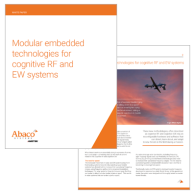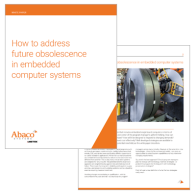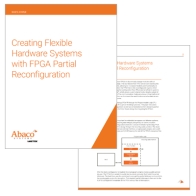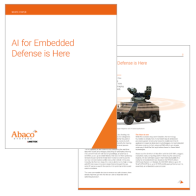Share
Share
Share
Share
Share
Share
Share
Search
White Papers
| Title: | Release Date | Description |
|---|---|---|
| VME Forever ! | March 2017 | VME has been at the heart of rugged embedded computing for over 30 years. Alternative architectures have come along – but VME is still thriving. And: there are good reasons why VME will continue to thrive – as this white paper explains. |
| Video Tracking Developments Afford Greater Range of Deployed Platforms | May 2011 | This white paper looks at the engineering benchmarks of video tracking systems in military and aerospace deployments, and how Abaco Systems video tracking devices meet those technological requirements. |
| Video Image Fusion for Real-Time Systems | January 2010 | |
| Video Electronics Designed with the Unmanned Vehicle in Mind | May 2010 | This white paper describes some of the key considerations encountered during the development of the ICS-8580 rugged video streaming XMC board, with a particular focus on the selection of video codec, which is one of the critical decisions in any video streaming application. An analysis will be made of the two most common video codec’s, JPEG2000 and H.264 (MPEG-4 part 10) to determine which one is better suited to solving the demands for greater computing capability, ruggedness, power consumption, flexibility, and physical size limitations specifically with unmanned vehicles. |
| Vetronics Architectures Emerge to Facilitate Network-Enabled Operations | August 2011 | Battlefield communications capabilities have emerged as a top military priority. As a result, vehicle electronics (often combined as “Vetronics”) architectures are evolving to ensure that military assets can effectively serve as part of a holistic communications network. Our new white paper, Vetronics Architectures Emerge to Facilitate Network-Enabled Operations, reviews the genesis and implementation of the NEO paradigm, and explores how Vetronics architectures are changing communications among virtually all battlefield assets. |
| Using Modular Building Blocks in Wireless Networks | May 2005 | Published here with permission from Intel®, this paper describes how telecommunications companies can accelerate the rollout of new wireless technologies and services using Intel® building blocks in standards-based modular communications platforms. This approach enables a consistent architecture and a common set of hardware and software components to be used across the network, from access to core. It can dramatically accelerate time-to-market, and it enables carrier-grade solutions that are more flexible, scalable and affordable than traditional, proprietary platforms. |
| Tuning HPEC Linux Clusters for Real-Time Determinism | October 2013 | This paper investigates interrupt response times and message passing latencies using OpenMPI on three different versions of the Linux kernel; one ‘standard’ server grade, one server grade with real-time pre-empt patches applied, and one with a proprietary, real-time kernel. In order to characterize these platforms, a series of measurements were made with and without a background CPU load. This paper will also highlight some system and Linux kernel tuning techniques that can improve determinism and affect system performance. The results are presented in a series of graphs showing histograms of interrupt response and MPI message latencies under the various workloads and tuning scenarios. |
| Tuning and Verifying Application Data in the Dark | October 2016 | When the pressure is on to get programs fielded in the minimum time, developers use every trick available to shorten the time to application completion. Here, we describe one such trick: using intuitive graphics instead of impenetrable text. |
| TS-MPEG4 Video Compression Application Concepts | January 2009 | This white paper examines how to leverage the MPEG-4 PMC in a distributed ISR environment potentially involving a UAV. The real-time video compression and transmission solution, with dynamic distribution control, provides the ability to adjust video quality and redirect the compressed stream in mid-flight. Click on the attached white paper as these features are shown to be indispensable in the scenario discussed. |
| Transforming the Military Embedded Computing Landscape | November 2016 | This white paper describes the key market drivers, technologies and building blocks that the military is increasingly embracing from the commercial world that provide a clear path to increased operational capabilities within the size, weight and power (SWaP) constraints that are a feature of today’s most demanding programs. |
| Thunderbolt 3: a path forward for avionics data bus interfaces and Abaco’s ARINC 615-3 data loader | April 2019 | Engineers using avionics data bus interfaces and data loaders are facing a growing problem: the demise of the PCMCIA and ExpressCard interfaces, and the inadequacy of USB as an alternative. There is, however, a way forward. |
| The significance of Intel's Core i7 to embedded computing | February 2010 | The processors in Intel® Core® i3, Core® i5 and Core® i7 families included 12 targeted at embedded applications. These embedded processors have 7-year lifetime availability, which is a key feature for many embedded applications. This paper delves into their many other important features, including ECC memory, performance/watt and the integrated GPU. |
| The Role of Packet Processors | September 2009 | Universal connectivity offers numerous advantages, but also introduces new risks and concerns such as network management, monitoring and security. Packet Processors are built specifically to deal with these issues. They offer several advantages over traditional network processors because their hardware and software is tailored for packet movement, which gives them the ability to perform at multi-gigabit line rates. |
| Technology: insert or preserve? | October 2021 | One of the aspects of defense programs that is different is their longevity. That has significant implications for the technology that’s at their heart. Here, we look at the options available to maximize a platform’s viability well into the future. |
| Technologies for responding to rapid developments in cognitive RF and EW | April 2018 | Radar and EW applications are demanding more performance but with lower SWaP. Haydn Nelson, Director of Product Management, RF and DSP, describes the available technologies. |
| Technical Needs and Challenges in Harbor Surveillance | May 2009 | High frequency sonar applications are not a new concept. Navies of the world have been using high frequency sonar to seek out mines for the past sixty years. More recently however, a growing imperative to counter terrorist threats to harbors and coastal areas has created the need for a new range of high frequency sonar products, designed to detect and track specific surface and underwater targets such as divers, swimmers and water vehicles. As a consequence, COTS vendors of acquisition products have been forced to re-examine, and in some cases redesign, existing technical solutions to cope with the very demanding requirements of these applications. Click on the attached white paper to read the newest approaches to acquire and process high frequency sonar signals and the benefits over older traditional approaches. |
| Switched Fabrics Support High-Performance Embedded Computing for Military and Aerospace Platforms | June 2011 | This white paper explores how system integrators can leverage the switched fabric networking technologies found in HPC systems in the development of military and aerospace applications. |
| Switched Ethernet Latency Analysis | February 2009 | |
| Strategies for Open Architecture COTS Operating Systems | October 2016 | Open architectures enable our industry to benefit from a broad range of hardware and software choices – this white paper describes, they also provide a high degree of certainty that choices made today will provide maximum program longevity. |
| Software Strategies for Leveraging VXS Technology | December 2007 | Switched fabrics have been around for several years now, but with the advent of platforms such as ATCA, MicroATCA, VXS and VPX, their use is set to be ubiquitous. No longer is the fabric connection an afterthought, shoehorned into an architecture that was never designed to support such throughput, but it is now an integral part of the architecture, allowing for interconnects that are balanced with compute power now available with multi-gigahertz clock speeds and multiple cores. |
| Selecting the Optimal DSP Solution for EW Applications | June 2019 | In a rapidly changing technology environment, developers of advanced electronic warfare solutions face a sometimes bewildering array of choices. It’s not just about RF performance, though. Here, we describe some of the options and trade-offs. |
| Selecting a Bus Analyzer 101 | March 2016 | As Avionics buses on military and commercial aircraft become more varied and complex, a bus analyzer has become an important tool for use during integration, validation, deployment, and maintenance of avionics systems. Today's aircraft may contain MIL-STD-1553, ARINC 429, CAN, or ARINC 664 (AFDX) buses as part of the overall system. Choosing an analyzer needs to be a part of the overall system integration and test plan from the earliest phase of the project. |
| Secure Routers Protect Air, Land, and Sea Communications by Providing a Firewall Between Wireless LANs and Radio/Satellite Connections | March 2023 | Manned and unmanned land, air, and sea platform local area network (LAN) security has been overlooked for many years. However, because of increasingly sinister, competent, and faster threats that are harder to detect, the time has come to revisit how we protect these critical platforms. Sensitive satellite and radio communications must be secured, both incoming and outgoing, with readily available, up-to-date, router firewall technology. |
| Secure Networking: Five Things to Consider | June 2017 | With new threats constantly emerging, how can advanced switch management software help defend networks against cyber attack? David Herbert, Lead Software Engineer, provides the answers. |
| Replicating Human Reasoning with Sensor-driven Mobile Computing | October 2016 | Autonomous mobile platforms – whether automobiles or UAVs – need complex, sophisticated algorithms, and the computing power to deliver their output in near real-time. This white paper describes some of the approaches that have been taken. |
| Recent Focus on 10Gbps Ethernet Driven by Heavy Demand for Video | May 2011 | This white paper looks at the rapid rise of 10 Gigabit Ethernet as the new default communications channel for military embedded computing. |
| Real-Time Networking with Reflective Memory | September 2009 | A Reflective Memory network is a special type of shared memory system which enables multiple, separate computers to share a common set of data. Reflective Memory networks maintain an independent copy of the entire shared memory set in each attached system. Extremely low data latency is the key benefit of a high-speed, hardware-driven network like Reflective Memory. This low-latency performance is of paramount importance when building real-time systems such as simulators. |
| Real Time Ethernet | January 2006 | To many readers, the idea that Ethernet could ever be used for real-time applications is a contradiction in terms. Ethernet is famously unreliable because it does not establish a unique, dedicated connection between one sender and one receiver. Unless a dedicated connection can be introduced into this chaos, Ethernet has no role in real-time networking. This paper describes an innovative way to overcome this inherent limitation of Ethernet. |
| Readiness Level Measures Boosted By COTS Computers | July 2016 | Technology readiness level (TRL) and manufacturing readiness level (MRL) can be used to advantage by a systems developer to reduce time to market with new products, improve the value chain of the platform and make the system developer that much more competitive in the marketplace. Learn how a system developer can leverage the concepts of TRL and MRL to gain market advantage by downloading Abaco Systems “Readiness Level Measures Boosted by COTS Computers” white paper. |
| RDMA: The Future of High Speed Fabric Interconnects | October 2011 | In 1999, a proposal for next-generation I/O was introduced by Intel®, Microsoft® and Sun Microsystems® (now Oracle®). The collective goal was to define an optimal server and storage architecture. The resulting specification, known as System I/O, was released in October 2000. Today, this is known as InfiniBand. This white paper will explore the merits of this architecture as well as methods of optimizing its use. |
| Rapid Prototyping a High‑Performance Embedded Computing System | January 2017 | The availability of appropriate hardware can be a gating factor in the development of high performance, SWaP-constrained applications. However, this white paper describes an approach that can deliver a compelling process. |
| PCI Express Peer-to-Peer Interconnect | March 2011 | Its low latency, high bandwidth, widespread support and cost-effective silicon have made PCI Express ubiquitous. It can however, be used for more than merely communicating between a host and a peripheral: it has many advantages as a peer-to-peer communications technology. Enabling this, however, demands an understanding of how PCI Express works. This paper outlines the complexities that need to be understood and overcome – and describes a Abaco Systems software product that delivers a solution that masks those complexities from developers. |
| Packaging of Rugged COTS Systems | May 2010 | |
| OpenVPX System Bandwidth | May 2012 | This paper compares the bandwidth available to two common types of dataflow for systems based on the VITA 65 CEN16 central switched topology, using three different fabrics – Serial RapidIO (SRIO), 10 Gigabit Ethernet (10GbE), and Double Data Rate InfiniBand (DDR IB). |
| Open Standard Middleware Enables New Classes of HPEC Solutions | July 2016 | Commercial supercomputing and server farms have much to offer high performance embedded computing (HPEC) applications not only in terms of hardware, but also in terms of software. The capabilities available to embedded developers are described in this paper. |
| NVIDIA'S Tegra K1: A Game-Changer for Rugged Embedded Computing | July 2014 | GPU technology is already making significant inroads into applications such as radar, sonar and ISR that can readily benefit from the very high degree of parallelism offered by graphics processors. The extensive compute capability offered by GPU technology has, however, challenges with power consumption and heat dissipation – a concern in smaller, lighter weight platforms that do not have significant power at their disposal and that are problematic to cool. But: the limitations of deploying GPU technology in SWaP-constrained environments were largely eliminated when, earlier this year, NVIDIA® announced that Abaco Systems was its preferred provider of rugged solutions, destined for harsh, challenging environments, based on the Tegra® K1. |
| Network Engineering for Mission Critical Applications | May 2016 | Abaco’s flexible, secure, high performance switch management environment – and because we created it, we understand it in depth – and can modify it to suit unque customer needs. Here, we describe some of the problems we have solved. |
| Modular Embedded Technologies for Cognitive RF and EW Systems | January 2022 | New methodologies, often described as cognitive RF and cognitive EW, rely on reconfigurable hardware and software that can detect, learn about, and adapt to new threats in the field during a mission.
|
| Mil/Aero Thermal Management- Heat Pipes | July 2018 | The SBC347D 3U VPX single board computer can operate at full performance even at temperatures as high as 75°C. Here, Brian Hoden, Principle Mechanical Engineer, explains the cooling technology that makes this possible. |
| Mezzanine Cards Increase System Flexibility | May 2005 | Although PCI mezzanine cards (PMCs) were targeted for CompactPCI® (cPCI) and VME systems, they can be used on any form factor that provides the mechanical, electrical and signaling requirements. For example, Advanced Telecom Computing Architecture, or AdvancedTCA® carrier boards—designed for the telecommunications and data center markets—often include PMC slots to take advantage of the design flexibility of existing PMC products. In addition, a new mezzanine card, the AdvancedMC®, originally designed for AdvancedTCA systems is also being utilized on other systems. |








